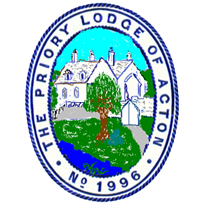Acton Priory
The name of our Lodge is derived from a house well known to Actorians as Acton Priory; Berrymead Priory or simply the Priory.
The age of the site is open to conjecture. Workmen are reputed to have come across Roman brick foundations. Later it is recorded that three Knights Templers “dwelt where the Priory now stands” in 1100 AD., two of whom went to the holy land. In 1200 AD. Forty Monks of the Benedictine Order brought the estate, built the house with a wing at either end, leaving a space for a garden at the front which was then westward.
Until 1244 it was owned by Peter de Aluph when it was passed to the Dean and Chapter of St Pauls. They kept it in their possession for 300 years, until the Reformation, when it was surrendered to King Henry VIII in 1544.
In the same year it was acquired by Lord John Russell, Lord Privy Seal, who afterwards inherited the title of Earl of Bedford. His only child, Anne, was married in June 1600 to Henry, Lord Herbert (afterwards Marquess of Worcester), a younger branch of the Somerset family, all of whose estates were sequestered during the commonwealth. The property was restored to them in 1682, passing to Henry Summerset, the great grandson of the first Marquess of Worcester.
By 1690 it was in the possession of George Saville, Marquess of Halifax who had decided to settle in Acton following the Commonwealth. It remained in the family until 1708 when it was purchased by Evelyn Pierrepoint, Earl of Kingston and Marquess of Dorchester who was subsequently created Duke of Kingston in 1715. He used it as a spring and summer residence. It passed in Turn to his second wife Isabel and then to her daughter Caroline.
In 1740 the house and 9 acres were sold to Miss Dorothy Fellowes and subsequently inherited by her brother, William.
During the course of sales which followed, it was owned by Henry Ord (1749), Thomas Fisher (1758), Thomas Whitmore (1787) and General Staats Long Morris (1790). On his death in 1800 it passed to his wife Jane and thence to her brother, James Edward Urquart. During this time, it was known as Berrymead Lodge. Urquart surrendered it in 1803 to Thomas Clutton, who remodelled it in the Gothic style and probably gave it the name Berrymead Priory.
Between 1807 and 1849 it had various owners, E.F. Akers (1807); Colonel Peacoke (1822), his wife (1830) and Son (1834); Messers Nicholson and Westcar (1838) and Mr Croft (1844). In the 1830’s it was leased to Edward Bulwer, Lord Lytton who took the house for his wife and lived there himself between 1835 and 1836. Later it was tenanted by Edwin Leaf, a silk merchant, and later General Alfo.
When the Nuns of the Sacred Heart took possession of the property in 1842 it was described as having finely wooded grounds totalling eleven and a half acres and surrounded by massive brick wall nine to ten feet high. The Nuns moved to Roehampton Lane in 1850.
Until 1851 the house was owned by Lt. George Trafford Heald, who married Lola Montez but had to leave England in order to escape bigamy charges.
In 1856 it was bought by John Dawson and remained in the family until 1882 when it was purchased by the Berkshire Estates Co. The house itself, which consisted of a galleried hall, six reception rooms and fourteen bedrooms on three floors, plus a small part of the garden, was sold to the Conservative Party in 1885 and opened in the following year as the Priory Constitutional Club. During this period of ownership there was extensive rebuilding but some of the Gothic detail has survived inside. The Club left after the Second World War and the property passed to Neville’s Bakery and thence to the London Borough of Ealing.
Earlier Lodge
The Records of Grand Lodge indicate that in 1723 there was in existence a “Lodge at the Crown at Acton”. There is no trace after 1725 and all subsequent endeavours have failed to trace the Crown at Acton. The only reasonable suggestion appears to be that it was on land now occupied by Crown Street which, with some property on the east side was formerly known as the Cock and Crown Yard until the early years of the present century.
Royal Oak Tavern
The Royal Oak Tavern was built about 1868 to the plans of W. Bro. Ed. Monson, F.R.I.B.A., a well known local architect and a keen and zealous freemason who played an important part in the affairs of the Lodge. It stood at the corner of the High Street and Market Place, on the site of an old dwelling house, forge and wheelwrights’ shop which had been occupied by the Aldridge family for two hundred years. One of the members of the family, William Aldridge, died in 1698 at the magnificent age of 115 years. His portrait at the age of 102, hung in the vestry of Acton Parish Church. A descendant, Thomas Aldridge, who was Parish Clerk for 46 years, died in 1800 at the age of 92.
It had a pillared portico in the centre of the frontage to the High Street which was eventually removed years later when it was fitted with a shop front. There was a large assembly room on the first floor wherein were held the lectures, concerts and other social functions of the time. In the early eighteen seventies and eighties it was the centre of all the important functions which were held in the town. The only other building of comparable capacity being the Acton lecture Hall and the Church School.
Although it was designed to be a hotel a licence was not granted, and it was opened instead as a coffee tavern.

